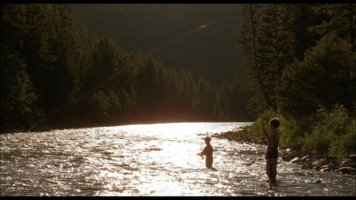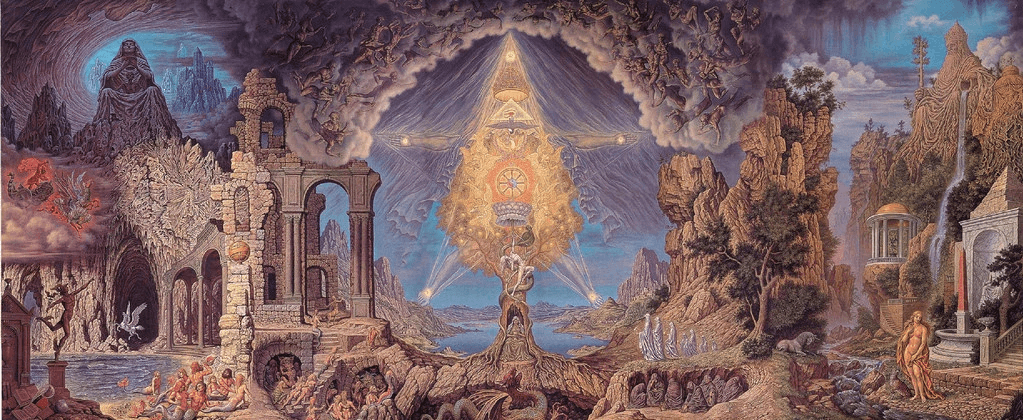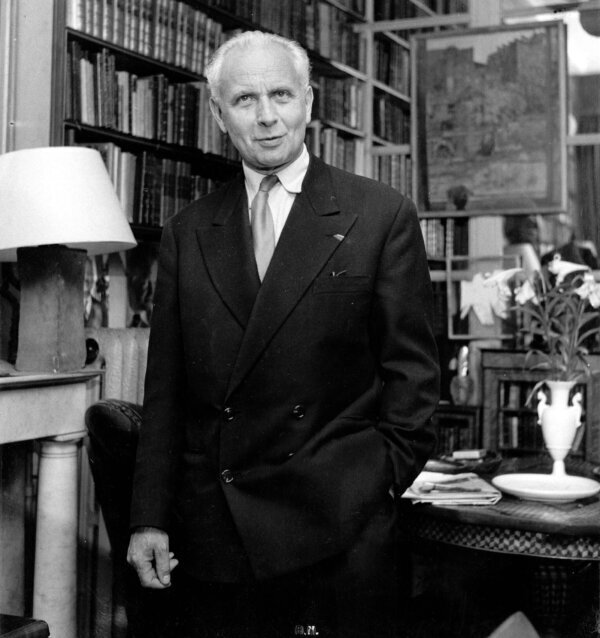A River Runs Through It

Norman Maclean was not my best teacher, but he was certainly the most memorable. And he taught truths not usually found in texts. Without talking much about his own life, he taught life-truths. Maclean revealed little more than bare facts: that he grew up in Montana, that he was the son of a Presbyterian minister, and that he had lapsed from the faith of his father. But I suspected that these were the most important facts. It was clear that he had seen and heard and done things in his Montana youth that had marked him for life—things that had turned him into a skeptical and somewhat hard-bitten man. Yet beneath the tough secular hide was an unmistakably religious heart.
Maclean was an excellent teacher of Wordsworth. His youthful experiences amid the Montana forests and mountains and rivers enabled him to dwell within Wordsworth’s poetry and to reveal its real power. Yet for all his passion and insight as a teacher, Maclean made it evident that, compared to the rough places of Montana, the university is a highly artificial and extremely privileged place. Even at their best, we learned from him, books have an indirect relation to life.
They bring too much order to life’s messiness. Perhaps this is why, though he was a superb scholar, Maclean never wrote a scholarly book. He spent his career teaching a paradoxical truth not found in most books: that the intellectual life is immensely important and yet supremely unimportant when set beside the task of ordinary living.
Maclean wrote A River Runs Through It and Other Stories after his retirement from the University of Chicago in 1973. Rejected by commercial publishers as neither pure memoir nor pure fiction—and as containing too many trees!—the book became an unexpected success when it was issued by the University of Chicago Press in 1976. Maclean’s account of the odd link between the art of fly-fishing and the art of living found a surprising resonance. Robert Redford was so moved by the book that he persuaded Maclean to grant him not only his permission but also his counsel in making the title story into a movie. It is a pity that Maclean died in 1990 and did not get to see Redford’s final product.
Given the limits of film—a thousand pictures are worth far less than a word in disclosing inner states of mind—the movie adaptation of A River Runs Through It is a fine success. Craig Sheffer is an uncanny younger version of what the mature Norman Maclean actually looked like. Brad Pitt, as the disaster-bound younger brother named Paul, has an equally uncanny resemblance to Redford himself. And in deftly selected voice-overs from the original text, Redford speaks in his own mellow tones as the older and wiser Maclean reflecting on the things he learned from his youth.
The film sometimes loosens the taut text of A River Runs Through It. Yet most of the liberties manage to catch its spirit. Maclean’s sardonic wit is echoed, for example, when Methodists are described as Baptists who have learned to read. In one affecting departure from the book, the movie shows Norman beginning but then his father completing the final lines of Wordsworth’s “Immortality Ode”:
Thanks to the human heart by which we live,
Thanks to its tenderness, its joys, and fears,
To me the meanest flower that blows can give
Thoughts that do often lie too deep for tears.
The film’s funniest episode, however—the hilarious sun-blistering of two drunken and passion spent lovers, one of whom possesses inventively tattooed buttocks—is not an invention.
A few reviewers have complained that the film lacks plot interest. The complaint is misplaced. The movie’s obligatory “action scenes”—a foolhardy running of extremely turbulent rapids at the beginning, a hyped-up “Old Man and the Sea” fishing episode at the end—are rather desperate cinematic attempts to generate outward excitement. The irony is that the book’s inaction is its very point. It poetic and inward-turning narrative seeks to capture the elusive spiritual pattern that makes our lives into significant stories rather than action-tales told by an idiot.
The film’s chief virtue is to have captured Maclean’s central conviction that the art of fly-fishing is a secular equivalent of what the Westminster Shorter Catechism regards as our chief reason for being: “to glorify God and to enjoy Him forever.” For Maclean, both religion and fly-fishing are forms of self-discipline; they are crafts of self-control. They teach us how to direct our attention away from our small selves to a high and worthy object. And they require a careful economy of effort, the grace to achieve maximal result with minimal exertion.
Evil, by contrast, is heavy-handed and graceless. “Until man is redeemed,” Maclean writes, “he will always take a fly-rod too far back, just as natural man always overswings with an ax or golf club and loses all his power somewhere in the air. . . . Power comes not from power everywhere, but from knowing where to put it on.”
Maclean’s narrative is riven by a contradiction. His brother Paul mastered the art of fly-fishing better than anyone else Norman knew, yet he ended his life in dissolute drinking and gambling and fighting. He was a dextrous artist with a fly-rod but a clumsy human being—a beautiful fisherman who could not live a beautiful life. Paul’s self-destructiveness is made evident from the beginning of the book. The film lets it emerge only gradually and thus misses the central pathos of the text: Norman’s early perplexity at knowing Paul’s woe but being helpless to avert it, unable even to speak to his brother about his soul’s secret anguish.
The movie resolves this conundrum by calling Paul “a work of art,” as if his fly-casting were a radiant act of perfection that, like all perfect things, is doomed to die. It is perhaps truer to say that Paul was a meteoric force of nature, burning himself out in a brilliant spate of vitality. The book answers the question of Paul’s ruin by refusing to answer it, leaving it encased in mystery. Faced with the wrenching task of telling the father about his son’s sordid end, Norman confesses his bafflement. Yet the saddened minister and his remaining son are still able to affirm their common faith: “You can love completely without complete understanding.” That not only love but faith precedes understanding is an ancient Christian claim.
This is but one of several points at which A River Runs Through It pushes beyond the natural to the theological. The doctrine of election, the most scandalous of all biblical teachings, turns out to be the truest. Like Abel and Isaac and Jacob, Norman seems strangely chosen. Like Cain and Ishmael and Esau, Paul seems strangely bound for perdition. Not for anything he has done or deserved is the one brother foreordained for long and gracious life, while the other brother seems predestined for early and desolate death.
Maclean the lapsed Presbyterian cannot declare with Job that the Lord who gives is also the Lord who takes away, and that his name is to be blessed in both the giving and the taking. But he can point to earthly signs of the transcendent Other that lifts up and casts down and puts to rest. The most vivid signals of such supernal terror and wonder are the mountain rivers—always cutting and curving, now hurrying, now eddying, sometimes draining into dry channels, but still carrying their load of rock and soil. Maclean recalls an especially luminous river-moment from his late youth:
As the heat mirages on the river in front of me danced with and through each other, I could feel patterns of my own life joining with them. It was here, while waiting for my brother, that I started this story although, of course, at the time I did not know that stories of life are often more like rivers than books. But I knew a story had begun, perhaps long ago near the sound of water. And I sensed that ahead I would meet something that would never erode so there would be a sharp turn, deep circles, a deposit, and quietness.
This man whose first love was for the outward and visible world also discerned an inward and invisible life everywhere around and deep within him. In a scene whose subtlety the movie could not depict, Maclean discovers that his father—now too old to fly-cast—is reading his Greek New Testament as he sits beside the Big Blackfoot River watching his sons as they fish. Norman sees that his father is reading the prologue to the Fourth Gospel. The son’s eyes fall on the word logos, and they are both reminded that the Word who became flesh is the same Logos that has been present from the beginning.
For the elder Maclean, John’s Gospel demonstrates that the Creator remains transcendent over the creation and can thus redeem it. “I used to think water was first,” he says, “but if you listen carefully you will hear that the words are underneath the water.” The son is not so sure. For him, the Logos is perhaps the Stoic principle of immanent unity that knits the cosmos into a seamless whole. The river voices reveal that nearly all life-stories end in tragic destruction, not divine redemption. For Maclean, life remains a mysterious “it,” a vast impersonal process wherein, as David Hume once said, “man matters no more than an oyster.”
Yet Maclean was not content with this hard creed. His residual faith caused him subtly to modify it. The truth is that the ever-cycling cosmos— what Nietzsche called the Eternal Return—is a huge circle intersected by thin lines. Maclean was too much the naturalist to perceive the bisecting threads as crosses. But his father’s Calvinism, with its deep providential sense of time and history, enabled the son to detect the world’s chief meaning in the linear and looping rather than the circular and repetitive, and thus in a One that creates the many:
Eventually all things merge into one, and a river runs through it. The river was cut by the world’s great flood and runs over rocks from the basement of time. Under the rocks are the words, and some of the words are theirs.
“I am haunted by these waters.”
These final words of the story and the film are an exquisite testament of both doubt and faith. Some of the truths told by the waters are nature’s own brutal realities. But the rivers that run through the cosmos are curving lines of transcendent beauty and power. These lines are traced not only in books but also in the doubt-wracked life that toughens true faith. The link between faith and doubt was first forged for me by Norman Maclean, and I am gratefully haunted by his memory.
This was originally published as “Words under the rocks in The Christian Century, January 20, 1993.




